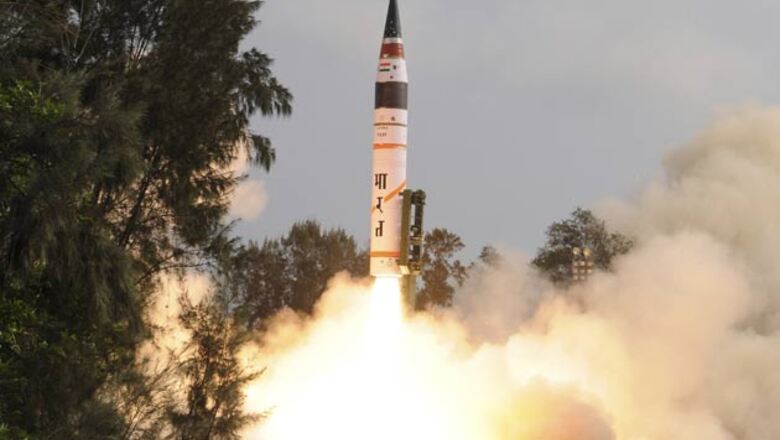
views
New Delhi: India's Integrated Guided Missile Development Programme (IGMDP) has conclusively got past its crucial make-or-break stage.
The programme, that was envisioned under the leadership of Mrs Indira Gandhi in the late 1970s and was started in the early 1980s, has been further consolidated with an exponentially expanded plan in the latter years to include every tactical and strategic stand-off platforms deemed necessary for the nation's defensive and offensive abilities.
Efforts by DRDO and other state-owned undertakings, some in joint ventures with Russian and Israeli defence firms, have produced a tactical ballistic missile series (Prithvi, versions of which have range varying between 150 and 750 km), a land-launched strategic ballistic missile series (Agni, whose versions range between 700 and 5000 km though the Agni V is believed to have a much greater range ), a submarine-launched ballistic missile series (K-series, whose versions tested till now, range between 750 and 3500 km but later versions are slated to travel beyond 6000 km), a solid-fuelled stand-alone 150-km range tactical ballistic missile (Prahaar), a third generation top attack anti-tank missile (Nag which is launched from NAMICA vehicles), a medium range surface-to-air (MRSAM) missile system (Akash), a long range surface-to-air missile (LRSAM) system in joint venture with Israel (Barak with range between 70 and 120 km), a 300-km range supersonic cruise missile system (Brahmos, whose actual range is actually believed to be much higher but the official range is stated to be 300 km to comply with Missile Technology Control Regime [MTCR] regulations as it is an Indo-Russian collaborative effort) among others.
Many of the above-mentioned platforms are operational with the various branches of the Indian Armed Forces. Some are in different stages of testing and fine-tuning.
Under development are further improvements of the Agni series, a hypersonic version of Brahmos, a long range cruise missile system (Nirbhay with range of 1000 km which is scheduled to be tested any day now). There are also murmurs about a ultra-long range surface-to-air missile system being under development though it has not been confirmed by the government. The said missile is supposed to complement the Swordfish/Green Pine radar system which is being integrated with other indigenous radar warning systems in an integrated seamless air defence network.
While the designs of the latter variants of the Agni series and the K-series, that is whatever is out there in the public domain, suggest that they will be capable of carrying multiple independently targetable re-entry vehicles (MIRVs), there is a complete blackout of information on India's research and progress in the MIRV field. The various state agencies involved with research on nuclear technology and every defence ministry official offer no comments about this. MIRVs allow a single missile to hit different targets spread over a large area with different nuclear warheads.
India's quest for missile technology has not been smooth. After India test-fired the first Prithvi missile in 1988 and the first Agni missile in 1989, the Missile Technology Control Regime, led by Canada, France, Germany, Italy, Japan, the United Kingdom and the United States, decided to restrict access to any technology that would help India in its missile development programme. Russia was in tatters; the Soviet Union had just collapsed. To counter the MTCR attempt in ensuring western monopoly over critical missile technology, India had to become self-reliant. A slew of public sector firms with independent research laboratories were set up throughout country to develop the technologies, the sub systems, the materials, the testing facilities.
The fact that India tests its missiles many more times unlike its neighbour to the west is a testimony to the self-reliance that India's missile development complexes have developed. Tried and tested technology platforms, whether imported, stolen (pirated) or smuggled, seldom require testing. But things developed from the scratch need to be put under repeated and rigorous tests.
Detractors or those who love to live in denial about India's progress in missile technology development jumped the gun after the Agni-V tests saying the guidance chips were imported. The Semiconductor Complex Limited (SCL) with its research lab was established in Chandigarh in 1983. Nearly all flight instrumentation systems of the IGMDP programme have come from there.
The development of the Indian Regional Navigational Satellite System (IRNSS) is crucial for India to gain autonomy in accurate targeting of missiles in a war-time situation. There is no guarantee that India will have access to the American GPS system in times of a military exigency. India has also struck a deal with Russia about access to the GLONASS system, Moscow's equivalent of GPS.
The IRNSS would consist of a constellation of seven satellites and a support ground segment. Three of the satellites in the constellation will be placed in geostationary orbit. These GEOs will be located at 34 East, 83 East and 132 East longitude. The GSOs will be in orbits with a 24,000 km apogee and 250 km perigee inclined at 29 degrees. Two of the GSOs will cross the equator at 55 East and two at 111 East. Such an arrangement would mean that all seven satellites would have continuous radio visibility with Indian control stations. The satellite payloads would consist of atomic clocks and electronic equipment to generate the navigation signals. The coverage is intended to extend beyond the subcontinental boundaries by 2000 km on all sides. The absolute position accuracy is stated to be better than 10 mtrs on land and better than 20 mtrs in the Indian ocean.
While this system is likely to be operational by 2014, there are reportedly plans to extend the coverage further. India has come a long way in terms of missile technology. And the best part is that it has resisted the temptation of smuggling technology or reverse-engineering to have quickfire solutions. It has invested in research and the learning curve is finally beginning to show concrete results.


















Comments
0 comment